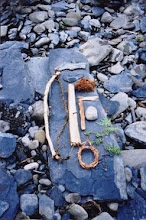Anyway, the dogbane is still in my car, filling up my trunk and back seat completely. I have to pull it out, separate it and then tie it into bundles that we can bring to our school programs or use in our summer camps for making bow drill cords, bow strings, arrow fletching, bracelets, snare cord, paiute deadfall cords, necklaces, fishing line and much more. You just can't have enough dogbane laying around! I will hang these up in our barn so we can grab it when needed for a class.

It is important to keep it dry and don't let it get wet when bundled or it will all mold and be no good. I check the stalks to make sure they have good fibers, that are strong and easy to peel and process. I don't harvest the tiniest plant stalks, generally, and try to get the largest ones with the longest stalks to make the best cordage.
Dogbane has a dark brown, almost mahogany colored stalk, and the fibers are a beautiful brown red color when peeled. The large branches at the top of the stalk have fibers in them too, but are hard to process easily, so we usually discard them during the classes. The leaves of dobgane are bright yellow during the fall, so they are easy to see from the road, along field edges and damp places. They sometimes have seed pods on the stalks that you should remove if you are gathering them before putting them in your car. Once I had a large bundle of dogbane that we left in our barn because it was wet, and then made a fire in the woodstove a few days later, and got the room all warm. The seed pods dried out and opened up, spreading fluffy seeds everywhere. It was funny but a huge mess. And the fibers were so fine that they caused a huge problem with breathing, too.
We had a great vacuum party and opened all of the windows and doors to try to get it out of there.... It was a lot of work! It has happened with milkweed, in my car, too, and even mullein stalks, although that was mostly dust, rather than seed heads. And it was very, very dusty and I sneezed for over an hour!

So, now is a good time to gather milkweed, which is easy to spot with their stalks bursting with white fluff from the seeds, and mullein, for hand drills and torches, and golden rod, for hand drills, and nettles, for cordage, and grasses, for grass mats and tinder. These plants are great to gather now, before they get pressed down by the snow and begin to decay.
Gather milkweed and select the ones that are very white and clean. The ones that are greenish, or dark grey and have black splotches usually are too far gone to make good cordage fibers. The white stalks (or light grey) are the best, with silky fibers that are fairly strong.
If you can find swamp milkweed, that stuff is really strong and very fine, too. Great for bow strings and anything that needs to be tough and strong. It loves water, so check the swamps, the water ways, drainage ditches, irrigation trenches and similar places. It is a perennial, so it will grow there again and again, which is great!
Anyway, hope this helps you get out there and get your year's supply of fire making and natural fiber resources!













3 comments:
Thanks for posting this! I needed some ideas for getting outside with my 2 boys (ages 4 & 6) in this cooler weather. I now have the inspiration I need to get outside find a little adventure and teach my little ones some skills :)
Jason
Elmira, NY
Glad I can help! There are some nice days in November and December, too, so you just have to dress right and then get out there and enjoy it! I gather grasses for tinder for my firemaking, cordage plants, all kinds of other projects, grape vines for baskets, arrow shafts, atlatl dart shafts, as well as cool sticks for carving and so forth. I found a site where a coyote killed a turkey, too so I got lots of feathers for my arrow fletching and our Holiday Wreath decorations....
Just be careful around hunting season, and wear bright colors as you gather. Better to be safe than sorry, I always say!
How did you hear about the blog?
Ricardo
Cherry Valley, NY
Ricardo,
Thanks for the tips! I can't be exactly sure of when I first heard about you and your blog but I think it may have been through a friend of mine also interested in primitive skills (he lives way up North in Dekalb).
Anyway - Please keep posting! Your blog has been a huge motivator for me to get out and start enjoying the things I really love again!
Jason
Elmira, NY
Post a Comment